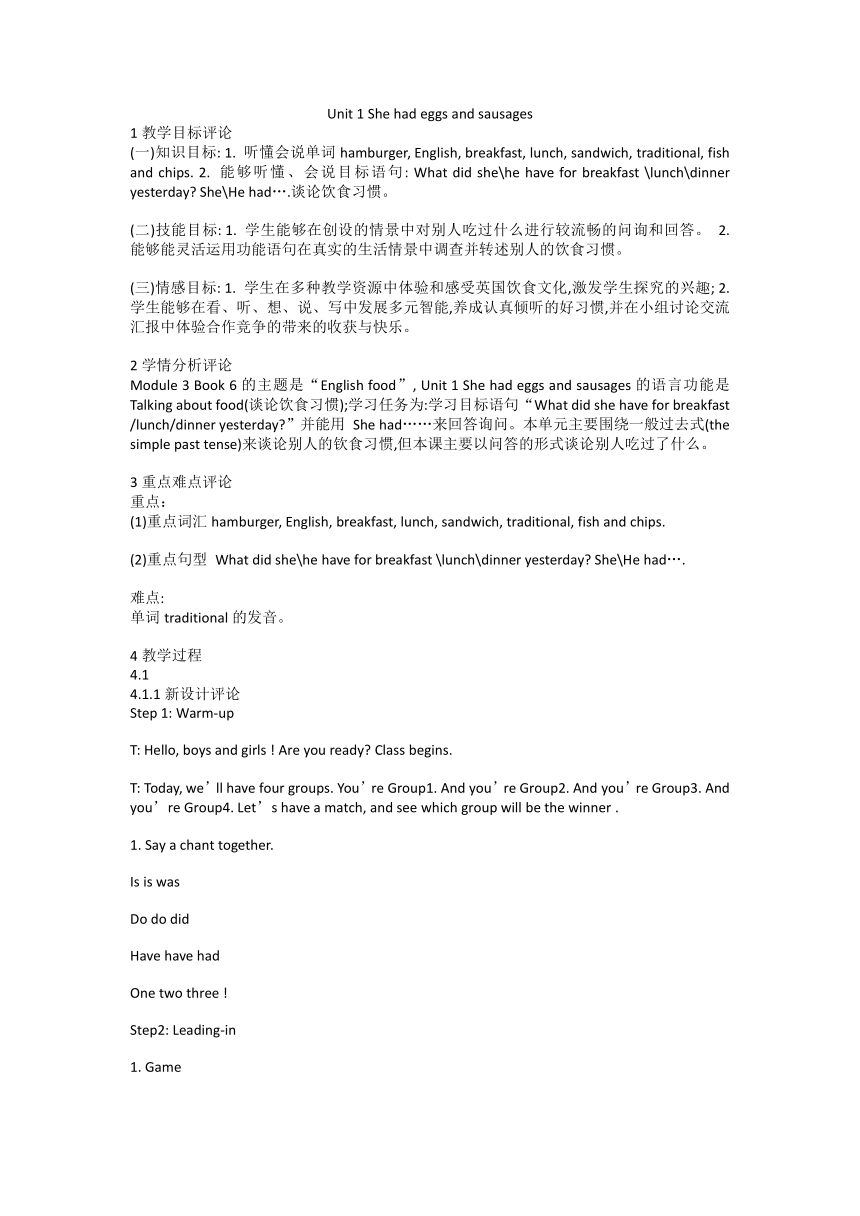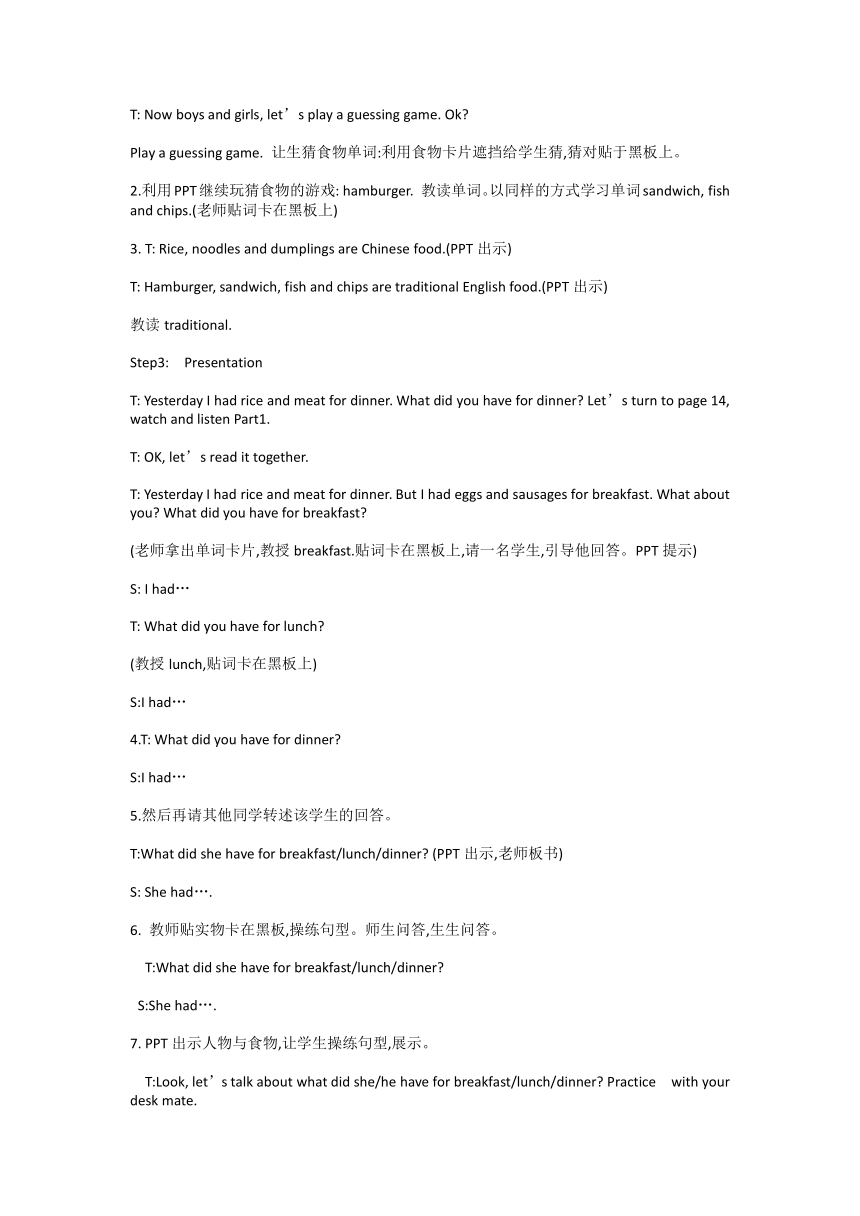Module 3 Unit 1 She had eggs and sausages 教案
文档属性
| 名称 | Module 3 Unit 1 She had eggs and sausages 教案 |

|
|
| 格式 | docx | ||
| 文件大小 | 16.0KB | ||
| 资源类型 | 教案 | ||
| 版本资源 | 外研版(三年级起点) | ||
| 科目 | 英语 | ||
| 更新时间 | 2021-09-22 19:24:45 | ||
图片预览


文档简介
Unit
1
She
had
eggs
and
sausages
1教学目标评论
(一)知识目标:
1.
听懂会说单词hamburger,
English,
breakfast,
lunch,
sandwich,
traditional,
fish
and
chips.
2.
能够听懂、会说目标语句:
What
did
she\he
have
for
breakfast
\lunch\dinner
yesterday?
She\He
had….谈论饮食习惯。
(二)技能目标:
1.
学生能够在创设的情景中对别人吃过什么进行较流畅的问询和回答。
2.
能够能灵活运用功能语句在真实的生活情景中调查并转述别人的饮食习惯。
(三)情感目标:
1.
学生在多种教学资源中体验和感受英国饮食文化,激发学生探究的兴趣;
2.
学生能够在看、听、想、说、写中发展多元智能,养成认真倾听的好习惯,并在小组讨论交流汇报中体验合作竞争的带来的收获与快乐。
2学情分析评论
Module
3
Book
6的主题是“English
food”,
Unit
1
She
had
eggs
and
sausages的语言功能是Talking
about
food(谈论饮食习惯);学习任务为:学习目标语句“What
did
she
have
for
breakfast
/lunch/dinner
yesterday?”并能用
She
had……来回答询问。本单元主要围绕一般过去式(the
simple
past
tense)来谈论别人的钦食习惯,但本课主要以问答的形式谈论别人吃过了什么。
3重点难点评论
重点:
(1)重点词汇hamburger,
English,
breakfast,
lunch,
sandwich,
traditional,
fish
and
chips.
(2)重点句型
What
did
she\he
have
for
breakfast
\lunch\dinner
yesterday?
She\He
had….
难点:
单词traditional的发音。
4教学过程
4.1
4.1.1新设计评论
Step
1:
Warm-up
T:
Hello,
boys
and
girls
!
Are
you
ready?
Class
begins.
T:
Today,
we’ll
have
four
groups.
You’re
Group1.
And
you’re
Group2.
And
you’re
Group3.
And
you’re
Group4.
Let’s
have
a
match,
and
see
which
group
will
be
the
winner
.
1.
Say
a
chant
together.
Is
is
was
Do
do
did
Have
have
had
One
two
three
!
Step2:
Leading-in
1.
Game
T:
Now
boys
and
girls,
let’s
play
a
guessing
game.
Ok?
Play
a
guessing
game.
让生猜食物单词:利用食物卡片遮挡给学生猜,猜对贴于黑板上。
2.利用PPT继续玩猜食物的游戏:
hamburger.
教读单词。以同样的方式学习单词sandwich,
fish
and
chips.(老师贴词卡在黑板上)
3.
T:
Rice,
noodles
and
dumplings
are
Chinese
food.(PPT出示)
T:
Hamburger,
sandwich,
fish
and
chips
are
traditional
English
food.(PPT出示)
教读traditional.
Step3:
Presentation
T:
Yesterday
I
had
rice
and
meat
for
dinner.
What
did
you
have
for
dinner?
Let’s
turn
to
page
14,
watch
and
listen
Part1.
T:
OK,
let’s
read
it
together.
T:
Yesterday
I
had
rice
and
meat
for
dinner.
But
I
had
eggs
and
sausages
for
breakfast.
What
about
you?
What
did
you
have
for
breakfast?
(老师拿出单词卡片,教授breakfast.贴词卡在黑板上,请一名学生,引导他回答。PPT提示)
S:
I
had…
T:
What
did
you
have
for
lunch?
(教授lunch,贴词卡在黑板上)
S:I
had…
4.T:
What
did
you
have
for
dinner?
S:I
had…
5.然后再请其他同学转述该学生的回答。
T:What
did
she
have
for
breakfast/lunch/dinner?
(PPT出示,老师板书)
S:
She
had….
6.
教师贴实物卡在黑板,操练句型。师生问答,生生问答。
T:What
did
she
have
for
breakfast/lunch/dinner?
S:She
had….
7.
PPT出示人物与食物,让学生操练句型,展示。
T:Look,
let’s
talk
about
what
did
she/he
have
for
breakfast/lunch/dinner?
Practice
with
your
desk
mate.
T:
OK,
who
can
show?
Step4
Text
learning
1.
T:
Do
you
know
what
did
Lingling
have
yesterday?
(老师指向黑板课题,引出课题)
She
had
eggs
and
sausages.
2.
T:
Lingling
sent
an
email
to
Daming.
Let’s
watch
and
listen,
What
did
she
say?
Then
answer
these
questions.(PPT出示)
(1)
What
did
Lingling
have
for
breakfast?
(2)What
did
Lingling
have
for
lunch
(3)What
did
Lingling
have
for
dinner?
(4)Does
Lingling
like
English
food
3.
Listen
again.
This
time,
listen
and
repeat
and
try
to
find
the
answer.
4.
Role-play
Boys
read
Daming.
Girls
read
Fanfan.
Understand?
Are
you
ready?
Step5
Extension
1.T:
You
do
very
well.
So
let's
play
a
game.
Game:
Test
your
memory
T:
Look
at
this
young
girl.
She’s
lucy.
She’s
my
new
friend.
She
is
from
England.
She
likes
English
food
very
much.
let's
see
what
did
she
have
yesterday.
Look
carefully.
(PPT:呈现Lucy昨天吃一日三餐的情景,然后食物消失。Give
the
Ss
3
seconds
to
look
),
Ask
one
pupil
to
come
to
the
front,
face
the
Ss,
others
ask
,
S1/S2/S3
answers.
2.情感升华
T:
Look
at
the
first
two
pictures.
Now
Chinese
people
often
eat
western
food.
Western
people
often
eat
Chinese
food.
The
world
work
together
now.
T:
Look
at
this
man.
How
fat
he
is
!
So
don’t
eat
too
much
for
dinner
.
I
have
a
suggestion
for
you
:To
eat
a
hearty
breakfast,
have
a
filling
lunch,
and
a
simple
light
dinner.
早餐吃好,午餐吃饱,晚餐吃少。
Step6:
Summary
T:
Boys
and
girls,
you
did
a
very
good
job
in
this
class.
Let's
see
what
we’ve
learnt
in
this
class.
Step
7:
Homework(
菜单式作业:1必做,2,3任选一个做)
1.
Listen
and
repeat
the
dialogue,
try
to
imitate
and
retell
the
dialogue.
2.用本节课学过的句型向你的朋友或学校的外教老师说一说你在email中了解到的Lingling的早餐、午餐和晚餐分别吃了什么。
根据调查,完成给John的email,
并发至John的邮箱Johnlondon2010@中。
1
She
had
eggs
and
sausages
1教学目标评论
(一)知识目标:
1.
听懂会说单词hamburger,
English,
breakfast,
lunch,
sandwich,
traditional,
fish
and
chips.
2.
能够听懂、会说目标语句:
What
did
she\he
have
for
breakfast
\lunch\dinner
yesterday?
She\He
had….谈论饮食习惯。
(二)技能目标:
1.
学生能够在创设的情景中对别人吃过什么进行较流畅的问询和回答。
2.
能够能灵活运用功能语句在真实的生活情景中调查并转述别人的饮食习惯。
(三)情感目标:
1.
学生在多种教学资源中体验和感受英国饮食文化,激发学生探究的兴趣;
2.
学生能够在看、听、想、说、写中发展多元智能,养成认真倾听的好习惯,并在小组讨论交流汇报中体验合作竞争的带来的收获与快乐。
2学情分析评论
Module
3
Book
6的主题是“English
food”,
Unit
1
She
had
eggs
and
sausages的语言功能是Talking
about
food(谈论饮食习惯);学习任务为:学习目标语句“What
did
she
have
for
breakfast
/lunch/dinner
yesterday?”并能用
She
had……来回答询问。本单元主要围绕一般过去式(the
simple
past
tense)来谈论别人的钦食习惯,但本课主要以问答的形式谈论别人吃过了什么。
3重点难点评论
重点:
(1)重点词汇hamburger,
English,
breakfast,
lunch,
sandwich,
traditional,
fish
and
chips.
(2)重点句型
What
did
she\he
have
for
breakfast
\lunch\dinner
yesterday?
She\He
had….
难点:
单词traditional的发音。
4教学过程
4.1
4.1.1新设计评论
Step
1:
Warm-up
T:
Hello,
boys
and
girls
!
Are
you
ready?
Class
begins.
T:
Today,
we’ll
have
four
groups.
You’re
Group1.
And
you’re
Group2.
And
you’re
Group3.
And
you’re
Group4.
Let’s
have
a
match,
and
see
which
group
will
be
the
winner
.
1.
Say
a
chant
together.
Is
is
was
Do
do
did
Have
have
had
One
two
three
!
Step2:
Leading-in
1.
Game
T:
Now
boys
and
girls,
let’s
play
a
guessing
game.
Ok?
Play
a
guessing
game.
让生猜食物单词:利用食物卡片遮挡给学生猜,猜对贴于黑板上。
2.利用PPT继续玩猜食物的游戏:
hamburger.
教读单词。以同样的方式学习单词sandwich,
fish
and
chips.(老师贴词卡在黑板上)
3.
T:
Rice,
noodles
and
dumplings
are
Chinese
food.(PPT出示)
T:
Hamburger,
sandwich,
fish
and
chips
are
traditional
English
food.(PPT出示)
教读traditional.
Step3:
Presentation
T:
Yesterday
I
had
rice
and
meat
for
dinner.
What
did
you
have
for
dinner?
Let’s
turn
to
page
14,
watch
and
listen
Part1.
T:
OK,
let’s
read
it
together.
T:
Yesterday
I
had
rice
and
meat
for
dinner.
But
I
had
eggs
and
sausages
for
breakfast.
What
about
you?
What
did
you
have
for
breakfast?
(老师拿出单词卡片,教授breakfast.贴词卡在黑板上,请一名学生,引导他回答。PPT提示)
S:
I
had…
T:
What
did
you
have
for
lunch?
(教授lunch,贴词卡在黑板上)
S:I
had…
4.T:
What
did
you
have
for
dinner?
S:I
had…
5.然后再请其他同学转述该学生的回答。
T:What
did
she
have
for
breakfast/lunch/dinner?
(PPT出示,老师板书)
S:
She
had….
6.
教师贴实物卡在黑板,操练句型。师生问答,生生问答。
T:What
did
she
have
for
breakfast/lunch/dinner?
S:She
had….
7.
PPT出示人物与食物,让学生操练句型,展示。
T:Look,
let’s
talk
about
what
did
she/he
have
for
breakfast/lunch/dinner?
Practice
with
your
desk
mate.
T:
OK,
who
can
show?
Step4
Text
learning
1.
T:
Do
you
know
what
did
Lingling
have
yesterday?
(老师指向黑板课题,引出课题)
She
had
eggs
and
sausages.
2.
T:
Lingling
sent
an
to
Daming.
Let’s
watch
and
listen,
What
did
she
say?
Then
answer
these
questions.(PPT出示)
(1)
What
did
Lingling
have
for
breakfast?
(2)What
did
Lingling
have
for
lunch
(3)What
did
Lingling
have
for
dinner?
(4)Does
Lingling
like
English
food
3.
Listen
again.
This
time,
listen
and
repeat
and
try
to
find
the
answer.
4.
Role-play
Boys
read
Daming.
Girls
read
Fanfan.
Understand?
Are
you
ready?
Step5
Extension
1.T:
You
do
very
well.
So
let's
play
a
game.
Game:
Test
your
memory
T:
Look
at
this
young
girl.
She’s
lucy.
She’s
my
new
friend.
She
is
from
England.
She
likes
English
food
very
much.
let's
see
what
did
she
have
yesterday.
Look
carefully.
(PPT:呈现Lucy昨天吃一日三餐的情景,然后食物消失。Give
the
Ss
3
seconds
to
look
),
Ask
one
pupil
to
come
to
the
front,
face
the
Ss,
others
ask
,
S1/S2/S3
answers.
2.情感升华
T:
Look
at
the
first
two
pictures.
Now
Chinese
people
often
eat
western
food.
Western
people
often
eat
Chinese
food.
The
world
work
together
now.
T:
Look
at
this
man.
How
fat
he
is
!
So
don’t
eat
too
much
for
dinner
.
I
have
a
suggestion
for
you
:To
eat
a
hearty
breakfast,
have
a
filling
lunch,
and
a
simple
light
dinner.
早餐吃好,午餐吃饱,晚餐吃少。
Step6:
Summary
T:
Boys
and
girls,
you
did
a
very
good
job
in
this
class.
Let's
see
what
we’ve
learnt
in
this
class.
Step
7:
Homework(
菜单式作业:1必做,2,3任选一个做)
1.
Listen
and
repeat
the
dialogue,
try
to
imitate
and
retell
the
dialogue.
2.用本节课学过的句型向你的朋友或学校的外教老师说一说你在email中了解到的Lingling的早餐、午餐和晚餐分别吃了什么。
根据调查,完成给John的email,
并发至John的邮箱Johnlondon2010@中。
同课章节目录
- Module 1
- Unit 1 We lived in a small house.
- Unit 2 She didn't have a television.
- Module 2
- Unit 1 She learnt English.
- Unit 2 Mr Li was a teacher.
- Module 3
- Unit 1 She had eggs and sausages.
- Unit 2 Sam ate four hamburgers.
- Module 4
- Unit 1 Let's make a home library.
- Unit 2 We can find information from books and CDs.
- Module 5
- Unit 1 It's big and light.
- Unit 2 It's too big for you.
- Module 6
- Unit 1 I went there last year.
- Unit 2 She visited the Tianchi Lake.
- Module 7
- Unit 1 My father goes to work at eight o'clock eve
- Unit 2 I'll be home at seven o'clock.
- Module 8
- Unit 1 Will you help me?
- Unit 2 I made a kite.
- Module 9
- Unit 1 We laughed a lot.
- Unit 2 Mum bought new T-shirts for you.
- Module 10
- Unit 1 Where are you going to go?
- Unit 2 I'm in New York now.
- Review Module
- Unit 1
- Unit 2
